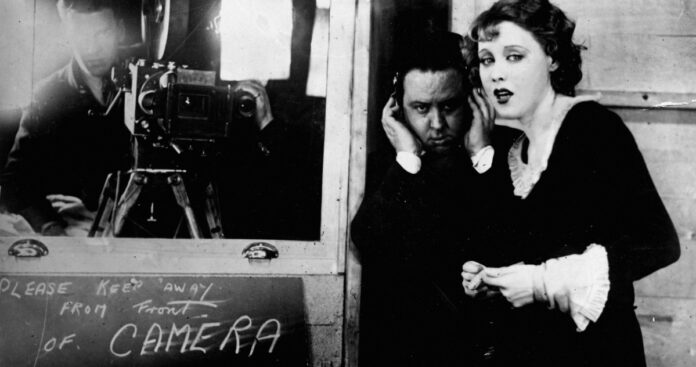This is a long overdue post, but perhaps I was simply enjoying the research too much. Picking up an occasional series on this site, here are some short reviews of new books on silent film that have passed across my desk recently. Yes, I am a lucky duck.
Silent to Sound: British Cinema in Transition, by Geoff Brown
John Libbey, 2024, $45.00
If a story is worth telling, and this one certainly is, then it is worth telling with style. In this case, Geoff Brown relates the story of the arrival of sound in the British film business with an eye for the eccentricities and absurdities that make it not just a pivotal moment in the medium, but a good yarn, and one that is revelatory about the national industry. Geoff Brown, journalist and researcher, has been studying the arrival of sound in Britain for years now as part of an AHRC-funded project and the result is this deeply enjoyable and admirably detailed book about a long and strange process, which when told with Brown’s light touch and quick humour is as diverting as it is informative. The serious point is that Brown’s emphasis, where he has access, is always on the films themselves. And that, along with the quotations from the critical discourse that I particularly cherish, is what really gives this book its colour.
Alfred Hitchcock is on the front cover, frowning as he wears headphones on set, but this is not simply the story of the Boy Wonder and Blackmail (1929). We begin, technically, in 1878 and the announcement of a “talking picture” by Victorian inventor Wordsworth Donisthorpe: this is how Brown lets you know that no stone will be left unturned. But soon we are in the 20th century and exploring various exploratory systems for combining sound and moving images and on to the race to making the first all-talking feature. Enter Lee De Forest and Theodore Case
This is where the more familiar names weigh in, and soon Maurice Elvey and his High Treason are going head to head with Hitchcock and his Blackmail to win the title of Britain’s first all-talking picture. After studying that production and its release into the world, Brown moves the story swiftly on, with chapters devoted to the early years of fully-fledged, if still limping, sound cinema in Britain, including dual-language productions, musicals, newsreels and documentaries. It’s absolutely faultlessly researched and breathlessly told – the most fun you will have learning about valves and vowel sounds, I promise you.
What Made Cinema? Essays on Visual Culture and Early Film, by Ian Christie
Sticking Place Books, 2025, $34.00
Professor Ian Christie needs no introduction to readers of Silent London – he has been researching and publishing on silent and early film for decades. And publishing in a variety of places. This gathered collection of essays represents around 30 years of work on early cinema, on pre-cinema, on the concept of immersive media and the business of film before there was a film business as we know it today – and it is a typically invigorating read. You will possibly have read some of these essays before, but Christie’s brisk prose rewards rereading, and together these papers form a long and fascinating history of early film. He has an eye for personalities as much as the process, and I enjoyed the “Pivotal Portraits” section, which includes Queen Victoria, Thomas Edison, Robert and Ellen Paul and Fred Karno. There are so many questions. Who was making these images and why? And how? And who was watching them?
As the title suggests, this is a book full of questions, most of them deftly answered, or at least satisfyingly investigated. It begins “What were moving pictures for?” (opening an essay on image-making technologies and toys from the kaleidoscope to the first “moving-picture apparatuses”) and goes on to investigate, and reconsider topics including stardom, how to staff a studio, the definition of a film. More arise: “Who invented cinema?” That’s a big one. “What made cinema?” is a safer phrase, of course, and the answer lies in what Christie calls the “combination of drives, discoveries, social and psychological factors that coalesced to create what became ‘cinema’ around 1912” – which is the vast and often slippery subject of this engrossing book.
First Women of Hollywood: Female Pioneers in the Early Motion Picture Business, by Mary Mallory
Lyons Press, 2025, $31
Mary Mallory means business. First Women of Hollywood is an anthology of those women who achieved certain roles, or statuses, before their female peers. And Mallory is looking at the entirety of the American film business. So we have a collection of stars, of various stripes, but also potted biographies of say, the first archivist (Iris Barry), the first projectionist (Nellie Bly Baker), the first composer-accompanist (Edith Lang), the first publicist (Beulah Livingstone), and many more, including a collection of executive roles. And of course I had to rush directly to the story of Gertrude Price, who in 1912 began reviewing films for the Scripps-McRae chain of papers and the Newspaper Enterprise Association.
Mallory, a California-based film historian whom you may know from her previous books such as Hollywoodland and Hollywood Celebrates the Holidays, has a remarkable range of references and knowledge, and it’s an addictive read: who doesn’t want to read the stories of women working in the early years of such a vast and complex business, whether drafting press releases, curling hair or writing screenplays? I am sure Mallory is aware that the land she treads can shift all too easily, that claiming “firsts” is a risky business, but every woman celebrated in this book deserves their due, regardless. For me the real value of this book lies in the behind-the-scenes figures, but naturally, the sections on say, Mary Pickford, “First Major Studio Founder, Actress-Producer” and Gloria Swanson, “First Fashion Icon” have alluring tales to tell. “These pioneers,” writes Mallory, “all opened the door to future generations of women looking to break into the industry themselves.” Arguably, those doors have as often banged shut as remained open, and for each of these chapters, there is a longer, harder history to follow. Mallory’s expansive book is a “foot in the door” if you will, and happily shares multiple narratives of abundant talent, ambition, ingenuity and courage.
People on Sunday, by Jon Hughes
BFI Film Classics, 2025, RRP £12.99
I am a big fan of the BFI Film Classics series, and this elegant study of People on Sunday by Jon Hughes is a great example of why they can be such valuable books. People on Sunday, a movie made by a collection of future greats in Berlin at the tail end of the silent era, is a strange artefact of film history. It is the single film made by a collective of talented young Berliners including Billy Wilder, two Siodmaks, Edgar G. Ulmer, Eugen Schüfftan and Fred Zinneman, “Just like that. Without a studio. Without money.” It’s hard to classify, being a drama with a documentary feel, a city symphony with characters and a plot. And it captures an evocative glimpse of the glory years of Weimar Berlin, before it was about to fall into Fascism, before the brilliant young talents who made this film would leave for pastures new. So this is a film that rewards the extended study and appreciation offered by books in this series.
Hughes, who works on German and cultural studies at Royal Holloway, is excellent at combing out the details of who did what, and usefully provides short biographies for all the filmmakers and the cast. Also he makes the necessary links between this film and movements that came after it, from Italian neo-realism to American indie cinema. Hughes takes an intriguing film, one that raises several questions as you watch, and patiently answers every one. And in so doing, he paints a picture of what it was like to be young, creative and broke in Berlin as the Twenties roared to a close.
Early Buster Keaton, by Lisa Stein Haven
Pen and Sword Books, 2025, £25
You may well be familiar with Professor Lisa Stein Haven’s meticulous work on silent comedy history: she has written books on figures such as Max Linder, Charlie and Sydney Chaplin. This similarly comprehensive, illustrated book attempts a daunting task, to tell a new tale about a well-documented life, that of Buster Keaton. To this end, Stein Haven gives us the rise, not the (prat)fall of the comedy icon, covering Keaton’s family background, childhood, vaudeville years and only the very first phase of his career in silent cinema, the Comique films, stopping at 1920. Stein Haven’s approach is what she calls “microscopic”, the product of scouring archive newspapers and industry papers, and this is a granular account, rich in fine detail.
Imaginative readers will likely feel transported to the stages and studios of Buster’s early days, as Stein Haven sifts the evidence to track the development of Keaton’s comic art almost gig by gig. Evocatively, she quotes the press coverage allotted to say, a remarkably flexible kid in a family vaudeville routine: “a healthy, roguish child with a lively dash in him that is irresistible. Without appearing unnaturally precocious or impertinent he manages to keep the audience in roars from the time he is dragged on stage by his father, sitting on a broom, until his exit, which he makes hanging on to his father’s leg.” Sounds like someone we know.
Hitchology: A film-by-film guide to the style and themes of Alfred Hitchcock, by Neil Alcock
DaneBank Books, 2024, £9.99
Put simply, this colourful and comprehensive introduction to the man we know as Hitch, is a labour of love. Film critic Neil Alcock is a Hitchcock devotee – you may have read his writing in magazines such as Empire over the years – and this book is the product of his passion for what he calls the “Hitchcanon”. It is intended as an introduction, for the newbie, to every single Hitchcock film. So after a little preparatory material, we go title by title, with occasional sidebars, starting with The Pleasure Garden (1925) – “The opening scene of Alfred Hitchcock’s 53-film canon has his mucky fingerprints all over it” – and ending in the Family Plot (1976).
You get what I am driving at – Alcock gives the silents equal billing with the sound films. As he ought. Even The Mountain Eagle (1925). The entries are brief, but lively, and knowledgeable. Eg, on Alma Reville: “This is one lady who mustn’t be allowed to vanish.” So this really would make a perfect guide to the project of watching, or rewatching, all of the Hitchcanon, wherever you start. He will make Hitchologists of us all.
You can read Alcock’s chapter on Rear Window here on the Empire site.
- Silent London will always be free to all readers. If you enjoy checking in with the site, including reports from silent film festivals, features and reviews, please consider shouting me a coffee on my Ko-Fi page.
- Silent London moved over to Bluesky a while ago now. Come join us there!









